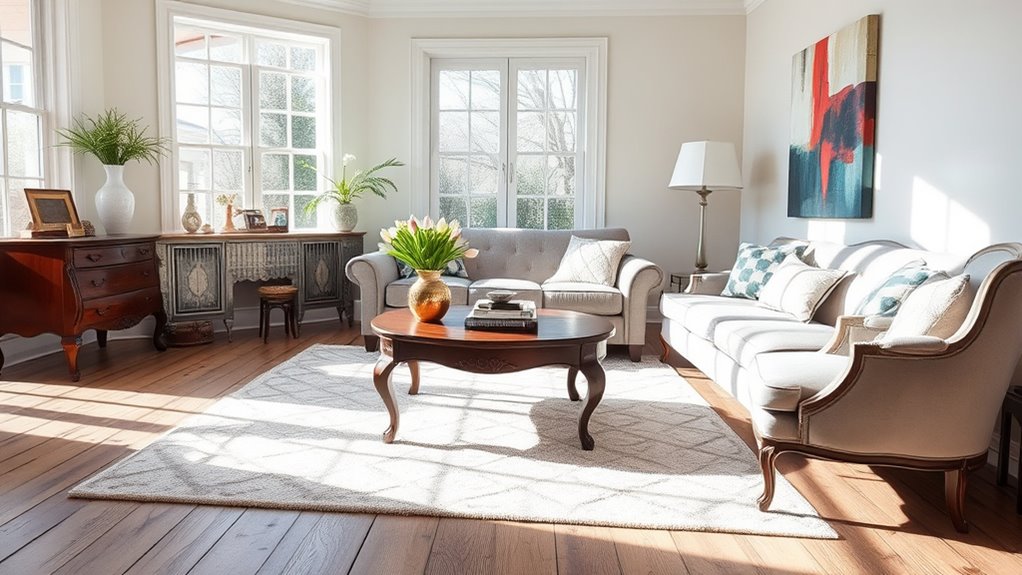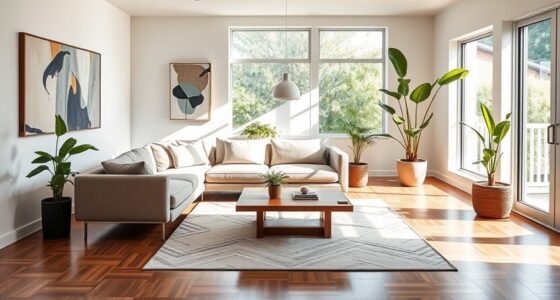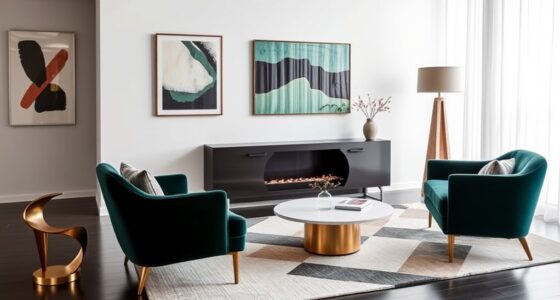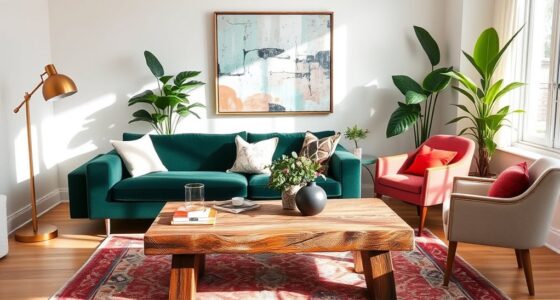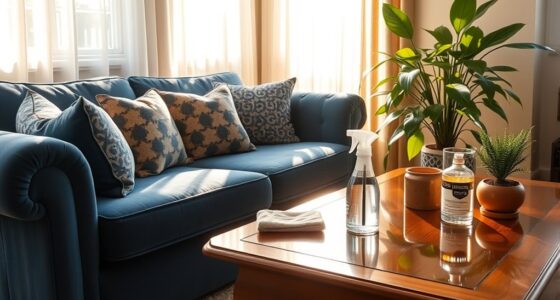Mixing vintage and contemporary home furnishings creates a unique space that reflects your style and story. Start with a cohesive color palette to unify the look. Aim for balance by ensuring 80% of your pieces are modern while allowing vintage items to shine as focal points. Combine textures for depth and comfort, layering different materials like linen and leather. Thoughtfully curating your collection can make your home feel personal and inviting. Discover more tips to perfect your space!
Key Takeaways
- Establish a cohesive color palette to create visual harmony and balance between vintage and contemporary furnishings.
- Apply the 80/20 rule by incorporating 80% modern pieces and 20% vintage items for a fresh yet timeless aesthetic.
- Mix textures by combining smooth modern surfaces with rough vintage materials to add depth and comfort to your space.
- Curate a collection of vintage items that reflect personal history and memories, enhancing the character of your home.
- Thoughtfully accessorize with vintage decor to personalize your space while ensuring a harmonious blend of old and new elements.
Understanding Vintage and Antique: Definitions and Differences
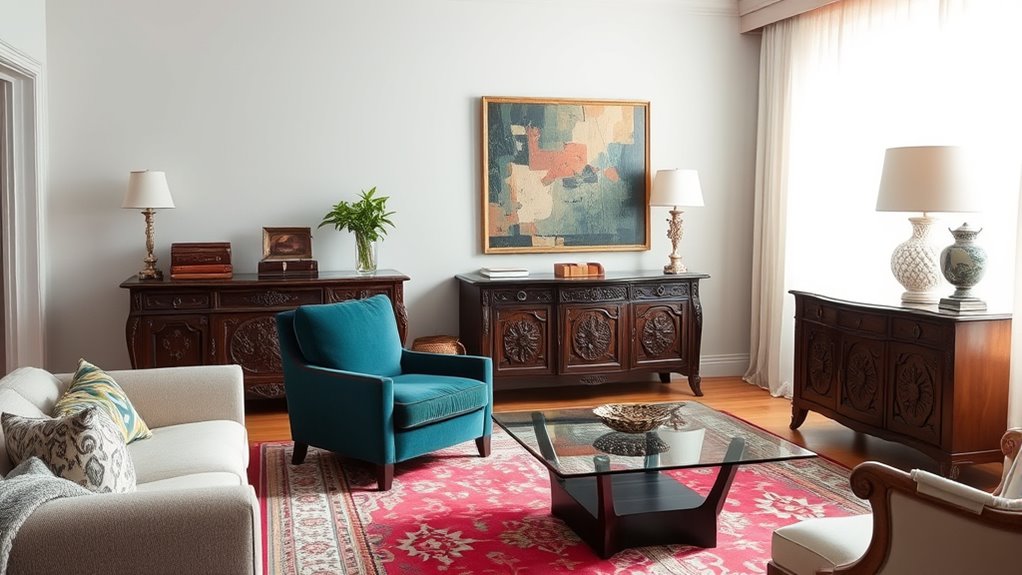
When you’re diving into the world of home furnishings, understanding the distinctions between vintage and antique items is essential.
Antiques are defined as items over 100 years old, showcasing the craftsmanship of bygone eras. They often exude a timeless charm that can elevate your space. Many antique pieces, such as farmhouse tables, are crafted from durable woods like oak, which enhances their longevity. The use of natural materials in antiques further accentuates their rustic appeal and connection to nature. Additionally, incorporating natural elements in your decor can create a more tranquil environment. For instance, using sustainable materials in your design not only supports eco-friendly choices but also adds to the overall aesthetic.
Antiques, over a century old, reflect exquisite craftsmanship and timeless charm that enhance any space.
On the other hand, vintage furniture refers to pieces that are more than 20 years old but less than 100, reflecting specific design trends from particular periods. This means you can find unique styles that bridge the gap between past and present.
Modern design, typically under 20 years old, leans toward sleek lines and functionality, while contemporary art captures the latest trends. Knowing these definitions helps you effectively mix styles in your home decor, especially when combining modern farmhouse style with vintage pieces for a cohesive look.
Establishing a Cohesive Color Palette
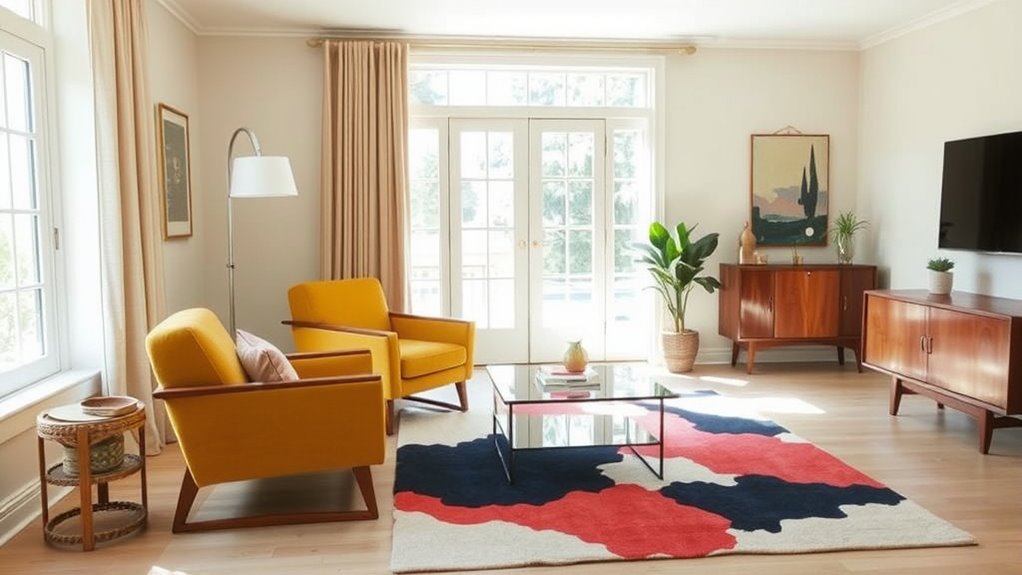
When you establish a cohesive color palette, you not only streamline your design process but also enhance the visual appeal of both vintage and contemporary pieces. Incorporating a color palette that aligns with the overall theme can create a harmonious blend of styles. Additionally, using warm color palettes can help to evoke a cozy and inviting atmosphere that complements both vintage charm and modern aesthetics. Effective color coordination can play a crucial role in achieving this balance. By selecting colors that reflect individual tastes and preferences, you can further personalize your space and create a unique atmosphere that resonates with your style. Embracing earthy tones can add a touch of sophistication while maintaining a sense of warmth in your decor.
Defining Color Schemes
Creating a cohesive color palette is essential for seamlessly blending vintage and contemporary furnishings in your home. By focusing on a scheme that incorporates blues, greens, and warm neutrals, you streamline the design process and enhance the aesthetic appeal of your space.
This approach allows for the successful integration of vintage and modern pieces while maintaining visual harmony. When curating your collection, stick to your established color palette to prevent clutter and chaos.
You can occasionally deviate from this palette in specific rooms for a personal touch, but guarantee overall cohesion throughout your home. Incorporating vintage art and accessories within your color scheme reinforces your confident approach to mixing vintage and modern styles.
Mixing Textures Effectively
While blending vintage and contemporary furnishings, effectively mixing textures can elevate your design and enhance visual appeal.
To truly mix vintage and modern elements, consider pairing smooth surfaces with rougher vintage materials, like sleek modern tables alongside rustic chairs.
Layering different textures, such as plush throw blankets and soft cushions on vintage furniture pieces, creates a cozy atmosphere that invites relaxation.
Incorporate natural materials like leather, faux fur, wool, and linen to introduce warmth, complementing both styles seamlessly.
Remember, a consistent cohesive color palette throughout these textures unifies various elements, preventing chaos in your space.
This balanced approach allows each piece to shine while contributing to an inviting, harmonious aesthetic.
Creating the Perfect Backdrop for Your Design
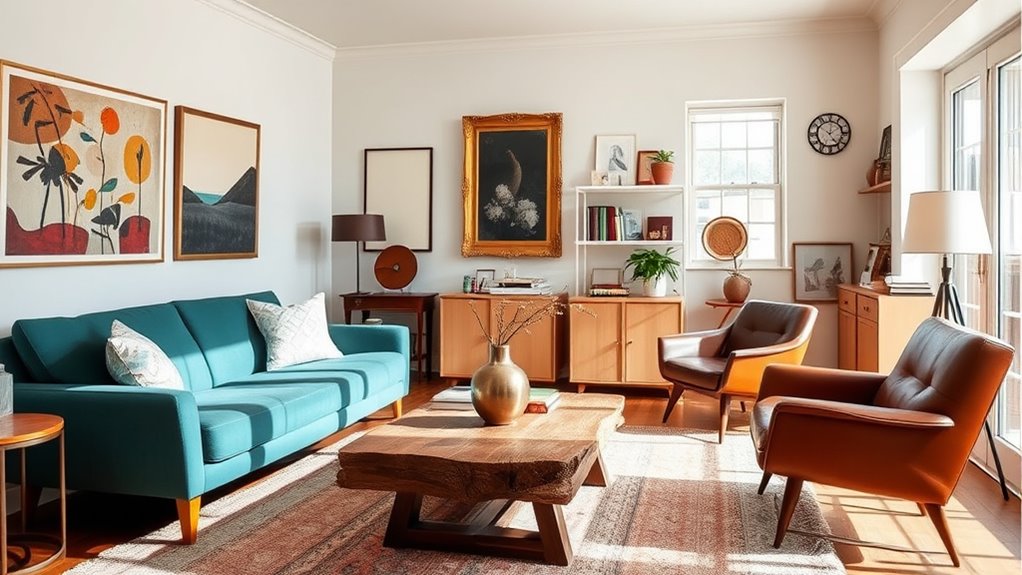
To create the perfect backdrop for your design, embrace the architectural features of your space, like high ceilings and large windows, which enhance natural light.
Keep window treatments minimal to maintain that openness, allowing both vintage and contemporary pieces to shine.
This approach not only makes your room feel more inviting but also highlights the unique character of each furnishing.
Utilize Architectural Features
When you embrace architectural features in your home, you set the stage for a stunning blend of vintage and contemporary furnishings. High ceilings and large windows create an airy backdrop, enhancing the visual appeal of both styles.
Incorporate original architectural features like moldings or exposed beams to add character and depth to your interior design. If your space feels less interesting, consider adding raw elements like exposed brickwork, which complements vintage pieces while providing a rustic touch.
Pairing vintage items with large contemporary art can create a striking visual contrast that draws attention. By utilizing these architectural features, you guarantee they remain a focal point, harmonizing beautifully with your unique mix of furnishings.
Maintain Minimal Window Treatments
Embracing architectural features sets the stage for showcasing your unique mix of vintage and contemporary furnishings, and maintaining minimal window treatments enhances this effect.
By choosing sheer curtains or simple blinds, you allow natural light to flood the space, highlighting both styles without overwhelming them.
Avoid heavy drapes or ornate coverings that clutter the room; they can detract from the beauty of your curated decor.
Instead, unembellished window treatments create a clean backdrop that complements your overall color palette.
This approach not only fosters an open, airy feel but also amplifies a sense of spaciousness, especially in smaller rooms.
Keep it simple to let your vintage and contemporary furnishings shine in harmony.
Successful Mixing of Vintage and Modern Elements
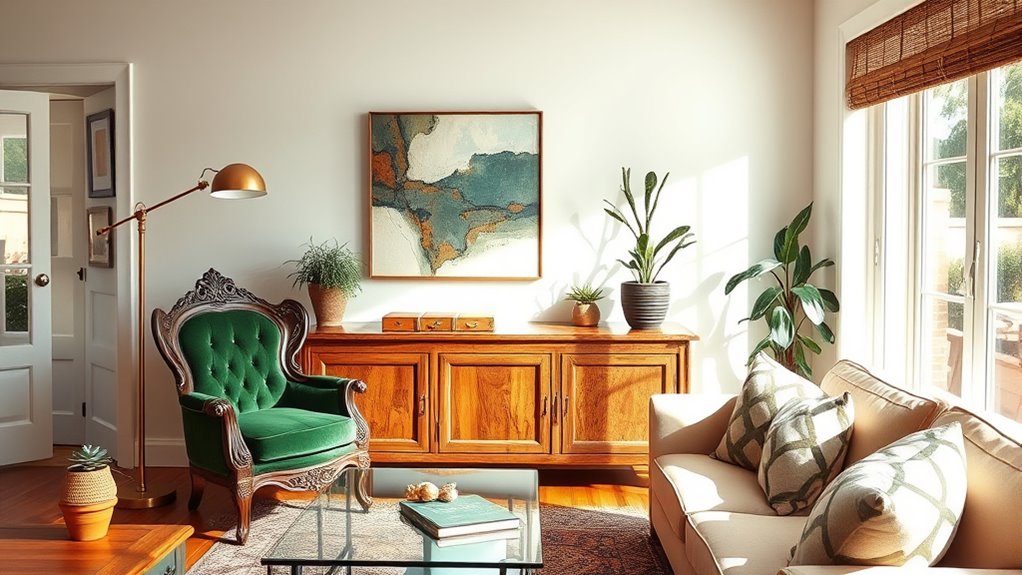
Successfully mixing vintage and modern elements in your home creates a dynamic and inviting atmosphere. To achieve this, start with a cohesive color palette that ties your vintage and modern decor together, ensuring visual harmony.
Focus on high-quality pieces and their proportions to maintain balance, allowing each item to shine without competing for attention. Layering textures is key; combine materials like a plush velvet sofa with a rustic vintage wooden table to add depth and warmth.
Thoughtful accessorizing, such as placing modern art alongside vintage decor or stacking antique books on minimalist shelves, personalizes your space and enriches its narrative.
With these strategies, you’ll create a curated yet lively environment that beautifully blends the old and the new.
Achieving Balance in Your Space
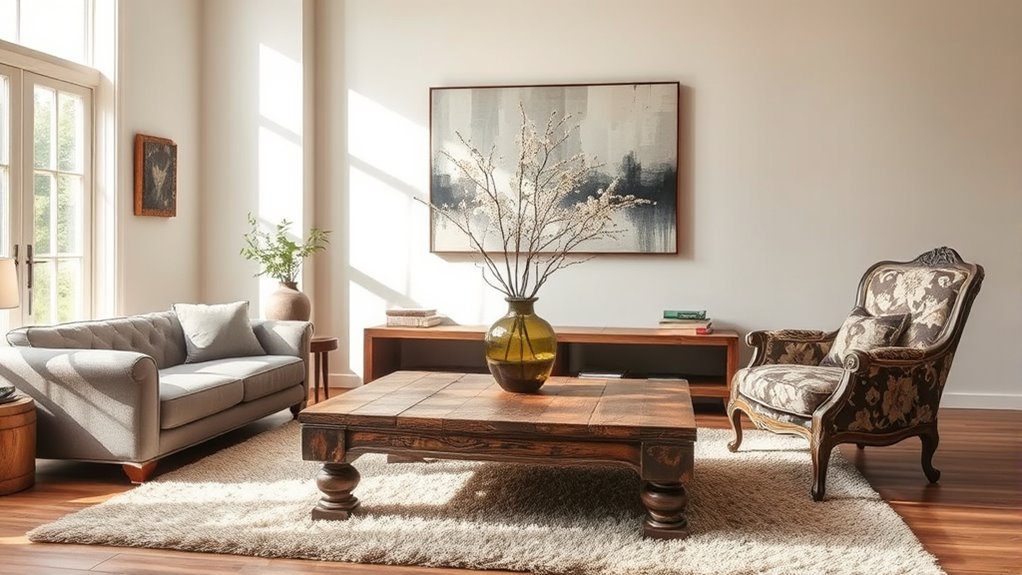
Creating a harmonious space means finding the right balance between vintage and contemporary elements.
To achieve this, consider these key strategies:
- Aim for 80% contemporary and 20% vintage pieces for a dominant theme.
- Group items thoughtfully to appreciate each piece without clutter.
- Distribute styles evenly throughout the space for a curated feel.
- Use a cohesive color palette to unify various styles.
Incorporating Textures and Layering
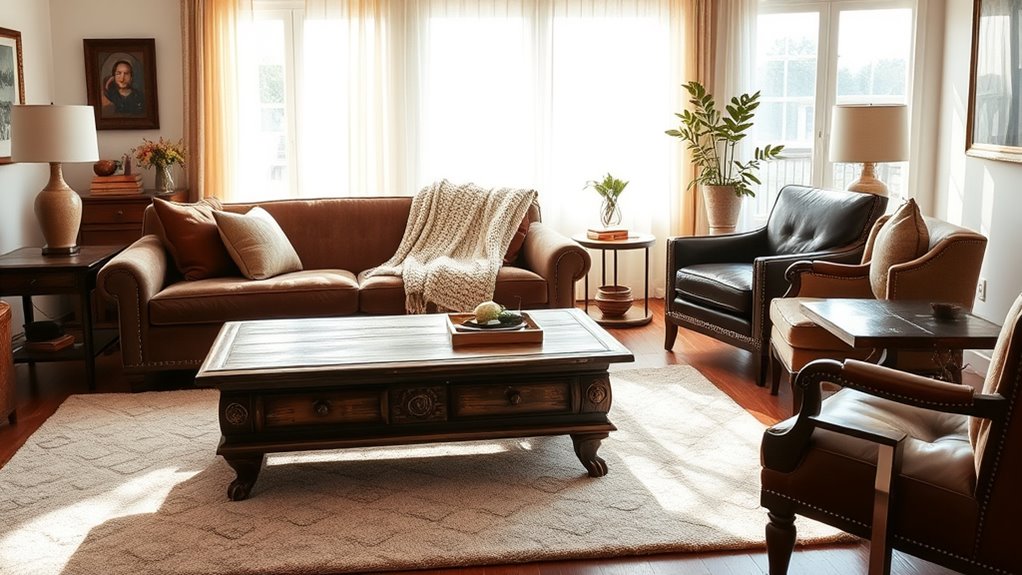
While balancing vintage and contemporary furnishings can be challenging, incorporating a variety of textures and layering can elevate your space considerably. Mixing vintage pieces with smooth surfaces and silky textures creates a relaxed ambiance, preventing chaos.
You can introduce natural textures like leather, faux fur, wool, and linen to enhance comfort and aesthetic appeal. Layering throws and cushions adds coziness and visual interest, making your room feel inviting and curated.
Don’t forget about lighting; incorporating a variety of lamps with different textures and finishes can enhance the overall design while providing functionality.
Embracing the 80/20 Rule for Design
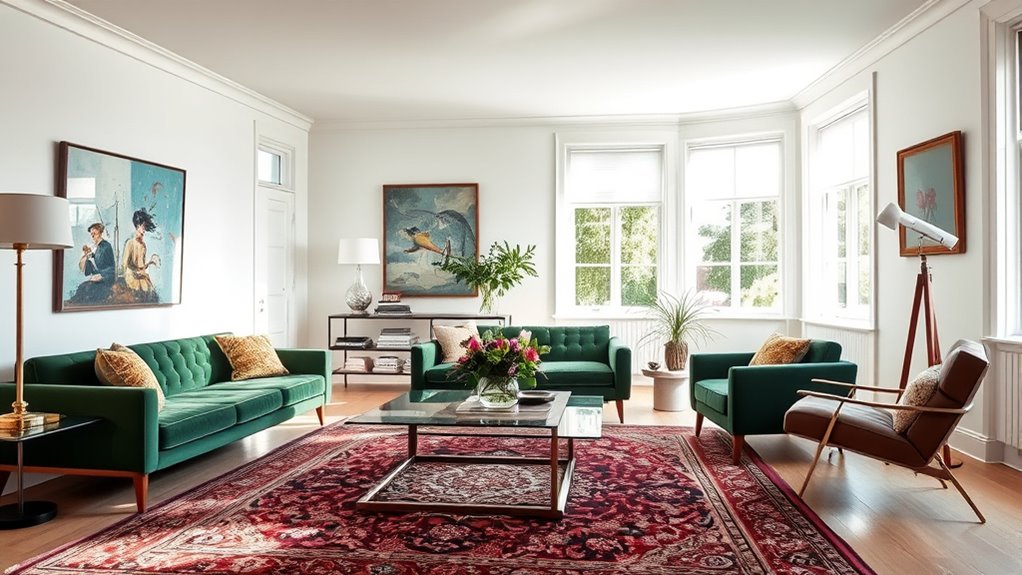
Mixing textures and layering can set the stage for a well-balanced home, but applying the 80/20 rule for design truly brings harmony to your space.
Mixing textures and layering with the 80/20 design rule creates a harmonious and balanced home environment.
By using 80% contemporary pieces and 20% vintage items, you create a cohesive look that feels modern yet retains character. This ratio allows vintage items to shine as focal points without overwhelming your decor.
- Highlight unique vintage finds
- Choose high-quality contemporary furnishings
- Maintain a curated environment
- Reflect your personal style effortlessly
This thoughtful approach helps you balance contemporary and vintage elements, ensuring the overall aesthetic feels fresh and timeless.
With careful curation, you express your individuality while achieving a harmonious blend in your home.
Curating Personal Collections Through Storytelling
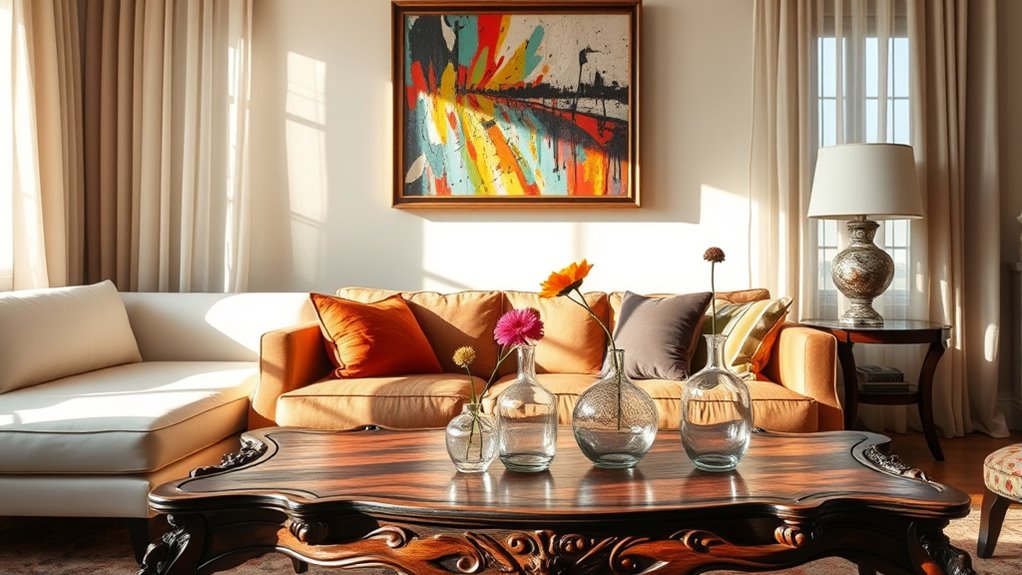
Curating a personal collection of vintage items not only showcases your unique experiences but also tells the story of your life. Each piece carries its own history, connecting you to different moments and memories.
By incorporating vintage decor into your modern spaces, you evoke nostalgia and add character that reflects your personality. Engaging in community activities, like vintage fairs and flea markets, helps you discover treasures while connecting with others who share your passion for curating.
Online platforms and social media offer endless inspiration for integrating past styles into contemporary designs. Through storytelling, you enhance the appreciation of each item, creating a home that feels genuinely personal and meaningful, blending the charm of vintage with the freshness of modern aesthetics.
Frequently Asked Questions
How to Mix Vintage With Modern Furniture?
To mix vintage with modern furniture, start with a neutral base color palette that lets both styles shine.
Aim for a balance, using about 80% contemporary pieces and 20% vintage items.
Integrate a cohesive color scheme, like blues and warm neutrals, to unify the look.
Combine different materials and textures, such as sleek glass with wooden vintage chairs.
Finally, accessorize with thoughtful pieces that reflect both eras, creating a personalized, curated space.
Can You Mix Contemporary and Traditional Furniture?
Absolutely, you can mix contemporary and traditional furniture!
To create a balanced look, aim for about 80% modern pieces and 20% traditional ones. This helps maintain harmony without overwhelming the space.
Pay attention to scale and proportion; pairing oversized traditional items with sleek modern furniture can create an appealing contrast.
Using a cohesive color palette and thoughtful accessories will also help tie the styles together, making your space feel curated and inviting.
How to Mix Contemporary and Mid-Century?
To mix contemporary and mid-century furnishings, start by aiming for an 80/20 balance, using 80% contemporary pieces and 20% mid-century items.
Focus on a cohesive color palette with warm neutrals and pops of mid-century colors like mustard yellow or teal.
Use mid-century statement pieces as focal points, and layer textures by combining smooth fabrics with rich materials.
Finally, incorporate retro-inspired accessories to create an eclectic yet intentional look that feels harmonious.
Can You Mix Rustic With Contemporary?
Sure, you could totally mix rustic with contemporary—unless you enjoy living in a bland box.
By blending reclaimed wood with sleek lines, you create a space that screams, “I have taste!”
Stick to a cohesive color palette, balancing heavier rustic pieces with modern flair to avoid chaos.
Throw in natural textures like jute or leather for that layered look.
Conclusion
By weaving together vintage and contemporary furnishings, you’re crafting a tapestry of stories and styles that dances through time. Each piece tells a tale, creating a home that feels both nostalgic and fresh, like a warm embrace from a long-lost friend. Remember, it’s not just about mixing elements; it’s about harmonizing them into a symphony of comfort and beauty. So go ahead, let your space reflect the unique journey of your life, where every corner whispers your story.
